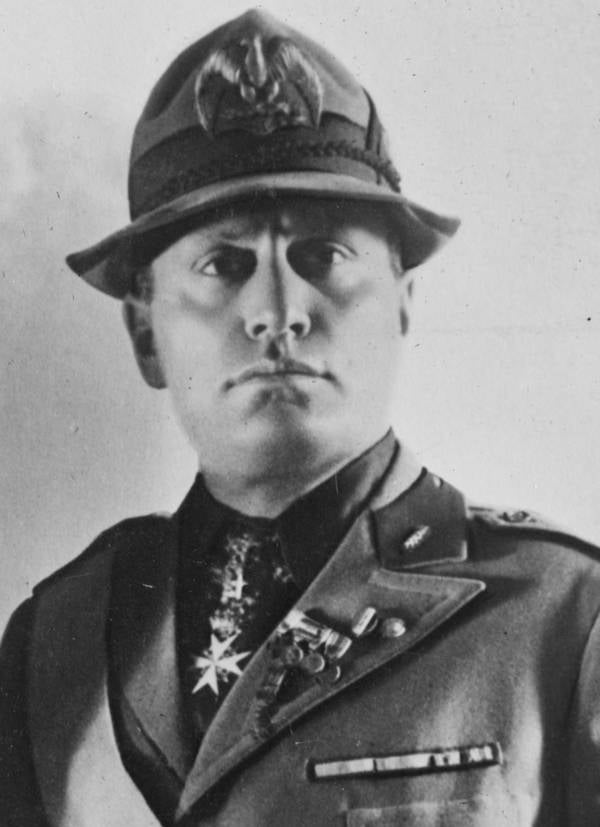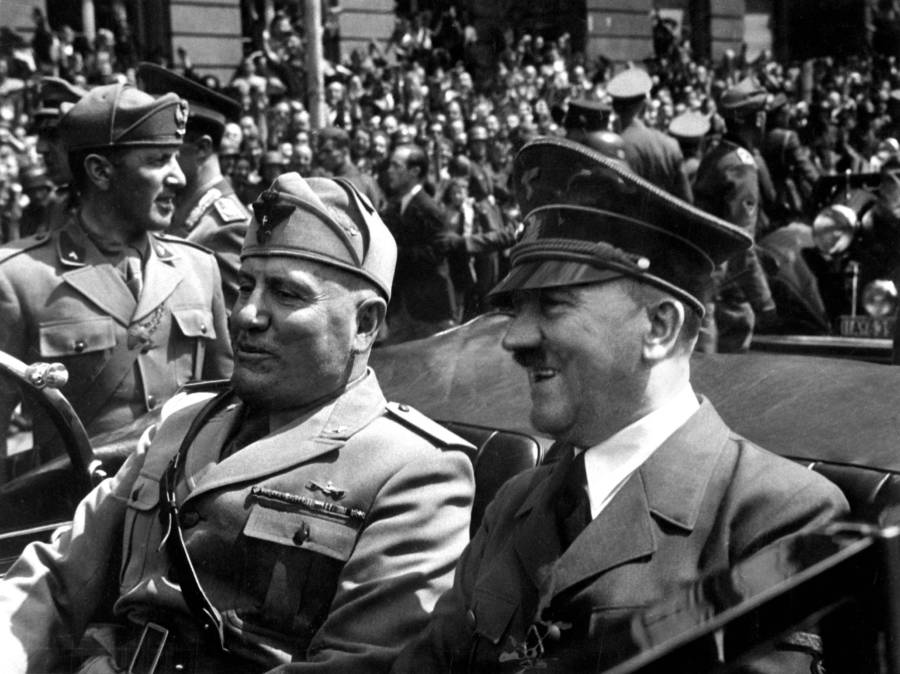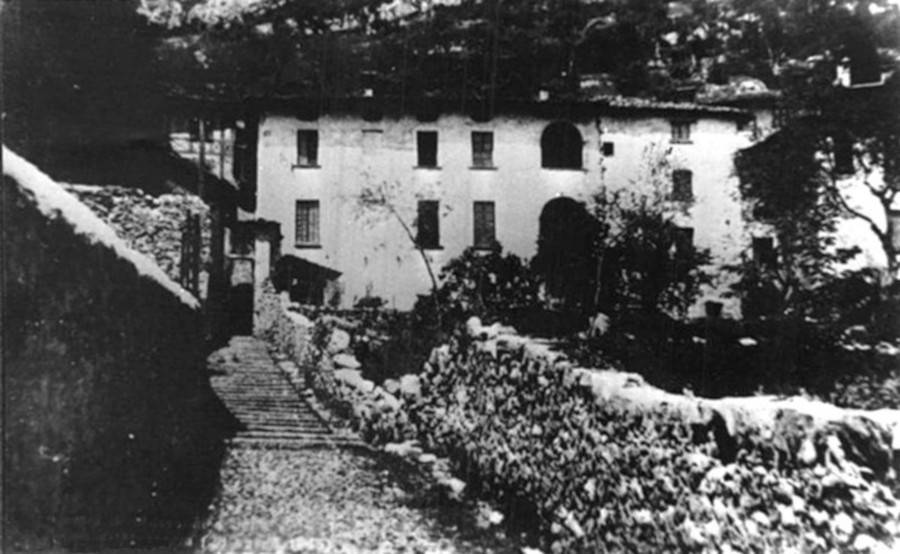On April 28, 1945, disgraced fascist dictator Benito Mussolini was brutally executed by Italian partisans in the village of Giulino di Mezzegra.
When Benito Mussolini, the tyrannical ruler of Fascist Italy before and during World War II, was executed on April 28, 1945, it was only the beginning.

Wikimedia CommonsBenito Mussolini, pictured before his brutal death.
Angry crowds strung up his corpse, spat on it, stoned it, and otherwise desecrated it before finally laying it to rest. And to understand why Mussolini’s death and its aftermath were so brutal, we must first understand the brutality that fueled his life and reign.
Inside Benito Mussolini’s Rise To Power
Benito Mussolini took control of Italy thanks to the pen just as much as the sword.
Born July 29, 1883, in Dovia di Predappio, Benito Amilcare Andrea Mussolini was intelligent and inquisitive from an early age. In fact, he first set out to be a teacher but soon decided that career wasn’t for him. Still, he voraciously read the works of great European philosophers like Immanuel Kant, Georges Sorel, Benedict de Spinoza, Peter Kropotkin, Friedrich Nietzsche, and Karl Marx.
In his 20s, he ran a series of newspapers that amounted to propaganda sheets for his increasingly extreme political views. He advocated violence as a way to effect change, particularly when it came to the advancement of trade unions and safety for workers.
The young journalist and firebrand was arrested and imprisoned several times for fostering violence in this way, including his support of one violent workers’ strike in Switzerland in 1903. His views were so extreme that the Socialist Party even kicked him out and he resigned from their newspaper.

Wikimedia Commons
Mussolini then took matters into his own hands. In late 1914, with World War I newly underway, he founded a newspaper called The People of Italy. In it, he outlined the major political philosophies of nationalism and militarism and violent extremism that would direct his later life.
“From today onward we are all Italians and nothing but Italians,” he once said. “Now that steel has met steel, one single cry comes from our hearts — Viva l’Italia! [Long live Italy!]”
A Transformation Into A Brutal Dictator
After his career as a young journalist and his service as a sharpshooter during World War I, Benito Mussolini founded Italy’s National Fascist Party in 1921.
Backed by increasing numbers of supporters and strongarm paramilitary squads dressed in black, the Fascist leader calling himself “Il Duce” soon became known for fiery speeches fueled by his ever more violent political worldview. While these “blackshirt” squads cropped up all over northern Italy — setting fire to government buildings, killing opponents by the hundreds — Mussolini himself called for a general worker’s strike in 1922, as well as a march on Rome.
When 30,000 Fascist troops did indeed enter the capital calling for revolution, it wasn’t long before Italy’s reigning leaders had no choice but to cede power to the Fascists. On Oct. 29, 1922, King Victor Emmanuel III appointed Mussolini prime minister. He was the youngest to ever hold the office and now had a wider audience for his speeches, policies, and worldview than ever before.
Throughout the 1920s, Mussolini remade Italy in his image. And by the mid-1930s, he began truly looking to assert his power beyond Italy’s borders. In late 1935, his forces invaded Ethiopia and, after a brief war ending with Italy’s victory, declared the country an Italian colony.
Some historians go as far as claiming that this marked the start of World War II. And when it did start, Mussolini took his place on the world stage like never before.
How Il Duce Entered World War II
Five years after the Ethiopian invasion, Benito Mussolini watched from the sidelines as Hitler invaded France. In his own mind, Il Duce felt it should be Italy fighting the French. Undoubtedly, however, the German military was bigger, better equipped, and had better leaders. Thus Mussolini could only watch, align himself with Hitler fully, and declare war against Germany’s enemies.
Now, Mussolini was in deep. He’d declared war against the rest of the world — with only Germany to back him up.
And Il Duce was also beginning to realize that Italy’s military was woefully under-classed. He needed more than just fiery speeches and violent rhetoric. Mussolini needed a strong military to back up his dictatorship.

Wikimedia CommonsAdolf Hitler and Benito Mussolini in Munich, Germany, circa June 1940.
Italy soon used its military might to invade Greece, but the campaign was unsuccessful and unpopular at home. There, people were still out of work, starving, and thus feeling rebellious. Without Hitler’s military intervention, a coup surely would have toppled Mussolini in 1941.
The Downfall Of Benito Mussolini
Facing pressure on the home front due to increasingly stressful wartime conditions and rebelliousness from within his own ranks, Benito Mussolini was removed from office by the king and the Grand Council in July of 1943. The Allies had re-taken northern Africa away from Italy and Sicily was now in Allied hands as they prepared to invade Italy itself. Il Duce’s days had been numbered.
Forces loyal to the Italian king arrested Mussolini and imprisoned him. Among those who had him ousted and arrested was his own son-in-law Gian Galeazo Ciano. The opposition then kept him locked away in a remote hotel in the mountains of Abruzzi.
German forces initially decided there would be no rescue before soon changing their minds. German commandos crash-landed gliders into the side of the mountain behind the hotel before freeing Mussolini and airlifting him back to Munich, where he could confer with Hitler.
The Führer convinced Il Duce to set up a Fascist state in northern Italy — where it all began — with Milan as its headquarters. That way, Mussolini could hold power while Hitler maintained an ally.
Mussolini returned triumphantly and kept suppressing his opposition. Members of the Fascist Party tortured anyone with opposing views, deported anyone with a non-Italian name, and maintained an iron grip in the north. German troops worked alongside the blackshirts to maintain order.
This reign of terror came to a head on Aug. 13, 1944. Fascists rounded up 15 suspected anti-Fascist partisans, or people loyal to the new Italy, in Milan’s Piazzale Loreto. With German SS soldiers looking on, Mussolini’s men opened fire and killed them. From that moment onward, partisans called this place the “Square of the Fifteen Martyrs.”

Wikimedia CommonsThe farmhouse in northern Italy where Benito Mussolini would be last seen alive.
In another eight months, the people of Milan would get their revenge on Mussolini — in an act that was equally as savage.
How Did Benito Mussolini Die?
By the spring of 1945, the war in Europe was over and Italy was broken. The south was in ruins as Allied troops advanced. The country was battered, and it was, many thought, all Il Duce’s fault.
But arresting Il Duce was no longer a viable course of action. Even though Hitler was surrounded by Allied troops in Berlin, Italy didn’t want to take any more chances with its own destiny.
On April 25, 1945, Benito Mussolini agreed to meet with anti-Fascist partisans in the palace of Milan. It was here that he learned Germany had begun negotiations for Mussolini’s surrender, which sent him into a fearful rage.
He took his mistress, Clara Petacci, and fled north where the pair joined a German convoy headed to the Swiss border. At least this way, Mussolini believed, he could live out his days in exile.
He was wrong. Il Duce tried to wear a Nazi helmet and coat as a disguise in the convoy, but he was instantly recognized. His bald head, deeply set jaw, and piercing brown eyes gave him away. Mussolini had developed a cult-like following and instant recognizability over the past 25 years — due to his face being plastered all over propaganda nationwide — and now it had come back to haunt him.
Fearing another rescue attempt of Mussolini by the Nazis, partisans whisked Mussolini and Petacci away to a remote farmhouse. The next morning, the partisans ordered the pair to stand against a brick wall near the entrance of Villa Belmonte, near Italy’s Lake Como and a firing squad shot the couple down in a barrage of gunfire. Upon Mussolini’s death, the final words he uttered were “No! No!”
Mussolini had come incredibly close to reaching Switzerland; the resort town of Como literally shares a border with it. Another few miles and Mussolini would have been free.

Keystone/Getty ImagesBenito Mussolini lies dead in Milan’s Piazza Loroto with his mistress, Clara Petacci.
But just like that, Mussolini’s violent life had come to a violent end. However, just because Mussolini’s death was now over, doesn’t mean the story was.
Still not satisfied, partisans rounded up 15 suspected Fascists and executed them in the same fashion. Clara’s brother, Marcello Petacci, was also shot dead while swimming in Lake Como, trying to escape.
And the angry mobs weren’t finished yet.
How Mussolini’s Corpse Was Mutilated After His Death
The night after Benito Mussolini’s death, a cargo truck roared into Milan’s Square of the Fifteen Martyrs. A cadre of 10 men unceremoniously dumped 18 bodies out of the back. They were those of Mussolini, the Petaccis, and the 15 suspected Fascists.
It was the same square where, a year earlier, Mussolini’s men had gunned down 15 anti-Fascists in a brutal execution. That connection was not lost on the residents of Milan, who then took out 20 years of frustration and fury on the corpses.
People began hurling rotten vegetables at the dictator’s corpse. Then, they took to beating and kicking it. One woman felt Il Duce wasn’t dead enough. She fired five shots into his head at close range; one bullet for each son she lost in Mussolini’s failed war.

Wikimedia CommonsBenito Mussolini, second from left, hanging upside-down in Milan’s public square.
This invigorated the crowd even more. One man grabbed Mussolini’s body by the armpits so the crowd could see it. That still wasn’t enough. People got ropes, tied them to the feet of the corpses, and strung them upside-down from the iron girders of a gas station.
The crowd yelled, “Higher! Higher! We can’t see! String them up! To the hooks, like pigs!”
Indeed, the human corpses now looked like meat hanging in a slaughterhouse. Mussolini’s mouth was agape. Even in death, his mouth couldn’t be shut. Clara’s eyes stared blankly into the distance.
The Aftermath Of Mussolini’s Death
Word of Benito Mussolini’s death spread quickly. Hitler, for one, heard the news on the radio and vowed to not have his corpse desecrated in the same fashion as Mussolini’s. People in Hitler’s inner circle reported that he said, “This will never happen to me.”
In his final will, scrawled on a piece of paper, Hitler said, “I do not wish to fall into the hands of an enemy who requires a new spectacle organized by the Jews for the amusement of their hysterical masses.” On May 1, mere days after Mussolini’s death, Hitler killed himself and his mistress. His inner circle burned his corpse as Soviet forces closed in.
As for Benito Mussolini’s death, that story wasn’t over yet. In the afternoon of the desecration of the corpses, both American troops arrived and a Catholic cardinal arrived. They took the bodies to the local morgue, where a U.S. Army photographer captured the macabre remains of Mussolini and Petacci.

Wikimedia CommonsA macabre autopsy photo of Benito Mussolini and his mistress in a Milan morgue. This was taken after the mob desecrated their bodies.
Finally, the pair were buried in an unmarked grave in a Milan cemetery.
But the location wasn’t a secret for too long. Fascists dug up Il Duce’s body on Easter Sunday of 1946. A note left behind said the Fascist Party would no longer tolerate “the cannibal slurs made by human dregs organized in the Communist Party.”
The corpse turned up four months later in a monastery near Milan. There it stayed for eleven years, until Italian Prime Minister Adone Zoli turned over the bones to Mussolini’s widow. She buried her husband properly at his family crypt in Predappio.
That still isn’t the end of the story of Mussolini’s death. In 1966, the U.S. military turned over a slice of Mussolini’s brain to his family. The military had cut out a portion of his brain to test for syphilis. The test was inconclusive.
After this look at Benito Mussolini’s death, read about Gabriele D’Annunzio, the Italian writer who inspired Mussolini’s rise to fascism. Then, take a look at photos from fascist Italy that provide a chilling look at life during Mussolini’s reign.






